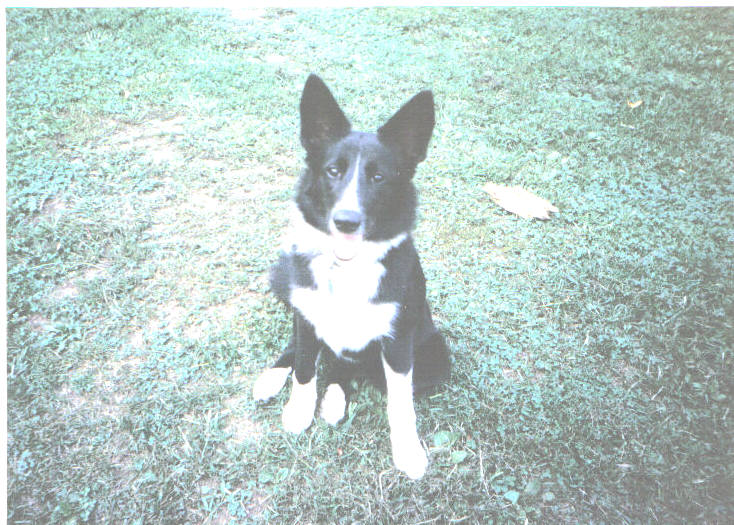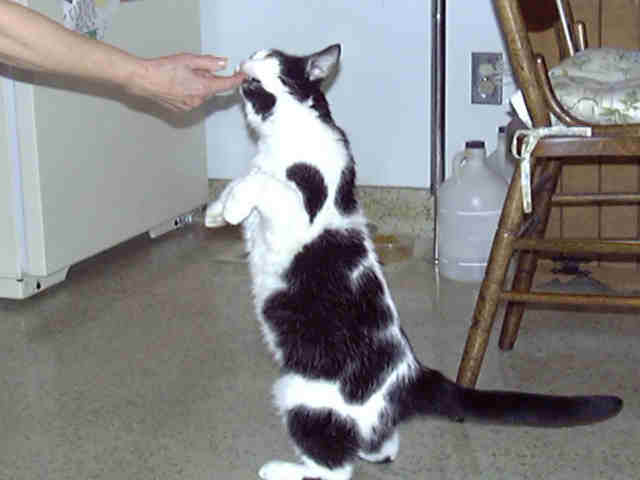Ethoxyquin and Preservatives in Dog and Cat Foods
Ethoxyquin....the "Bad Boy" on the Label
By:Tippy & Alfred
Our Border Collie, Tippy had experienced some serious problems in the past
that required 2 major surgeries. After the very expensive vet bill the second
time around, I finally asked the vet what was causing the problem.
He looked down at me with that professional stare and promptly announced it
was the garbage food we were feeding her.
His remedy was the particular brand of food that he was currently
promoting. All well and good. Of course I had never given nutrition a thought.
Dog food was dog food, and you bought whatever was cheapest......$9.95 for 50
pound was the norm.
Boy was I ever in for a surprise!
Tippy

So we switched to his brand, and also began a diligent search for the truth on
what the causes of disease in our pets were.
The more I studied, the more I became shocked at what was really being put
in our pets food. One recent conversation with one of our readers, who
happened to be a Regional Manager for Brand X, prompted me to write this
article.
For 5 years this very nice, intelligent, and quite caring lady had actively
promoted Brand X, until it became apparent that one substance in that food was
definitely proven to be a carcinogen. That brand also happened to be
the same one the vet had recommended we feed Tippy.
As she related to me, "I could no longer in good consciousness promote
that particular brand of food and so had to resign my job."
The bad boy on the label ==> Ethoxyquin
The U. S. Dept. of Agriculture for toxicology information lists ethoxyquin
in their Farm Chemical Hand-Book as a pesticide, used in fruit scald control.
It is also used as a rubber preservative. It is FDA approved for use as an
antioxidant for carotenes vitamin A and E and the prevention of the
development of organic peroxides.
It is approved at 150 ppm in paprika and chili powder, and because it is
used as a preservative in livestock feed, the following residue allowances in
human consumed animal products as follows: 5 ppm in or on the uncooked fat of
meat from animals except poultry; 3 ppm in or on the uncooked liver and fat of
poultry, 0.5 ppm in or on the uncooked muscle meat of animals, 0.5 ppm in
poultry eggs, and zero in milk.
The above information brings up the question why the FDA allows such a
small amount of ethoxyquin residue (5 to .5 ppm) in human consumed foods yet
allows such high amounts (150 ppm) to be used in pet food and livestock feeds?
In the case of the dog, pound for pound, a dog is consuming up to 300 times
more ethoxyquin than allowed for people. (depending upon the weight) Also many
dog food manufacturers are not always listing it as an ingredient on the
packaging, but sometimes merely print "E".
Check your dog or cat food label to see what the pet food you are using is
being preserved with.
Monsanto's (the manufacturer) own cautionary warnings in using and handling
this product: They warn that it may cause allergic skin reactions, irritation
to the eyes and skin. They advise that workers must wear eye and respiratory
protection. The container of ethoxyquin has a very prominent skull and
crossbones with POISON written in capital letters.
Ethoxyquin is listed and identified as a hazardous chemical under the
criteria of the OSHA Hazard Communication Standard (29 CFR 1910, 1220).
The Chemical Toxicology of Commercial Products says that ethoxyquin has a
toxic rating of 3 (on a scale of 1 to 6, with 6 being super toxic requiring
less than 7 drops to produce death). At that level it can slowly develop
depression, con-vulsions, coma and death; skin irritation and liver damage.
In a recent study by The Department Of Pathology, Nagoya City University
Medical School Japan, it was found: ethoxyquin promoted kidney carcinogenesis.
Also, it significantly increased incidence of stomach tumors and enhanced
bladder carcinogesis.
The FDA maintains it is safe, yet have asked pet food manufacturers to
"voluntarily" lower the levels to 75 PPM.
I've included some of the better sites that inform you of ethoxyquin below,
including the FDA report. I suggest you take some time and read these, then
you will be able to make an informed decision on your own. copy and paste each
link into your browser
www.fda.gov/bbs/topics/ANSWERS/ANS00119.html
www.canine-epilepsy-guardian-angels.com/Ethoxyquin.htm
www.mindspring.com/~woofsportsusa/petfoodpreservatives.htm
You know fellow pet lovers, I get a lot of letters from folks telling me about
their pet's sickness or diseases and then asking what they should do.
I'm really convinced that a major reason why our pets are getting sick is
because of the high levels of toxins in the foods, plus the nutritionally
inadequate foods they eat.
Believe me, it's far, far easier
& cheaper to prevent disease than try and cure it.
If you would like to learn more about a very high quality food that Does
NOT contain any harmful chemical preservatives and a food that will help to
enhance your dog or cat's life....
Here's one of Alfred's furry friends Begging for more of
the Life's Abundance Premium Cat Food & Supplement!
Does your dog or cat ask for it's food like this?
If not, then if it was on the Life's Abundance food & supplements,
your pet could act like this at feeding time!!!

Tippy & Alfred's Choice of Dining Experience for Dogs & Cats
See also:
More Pet Care Tips